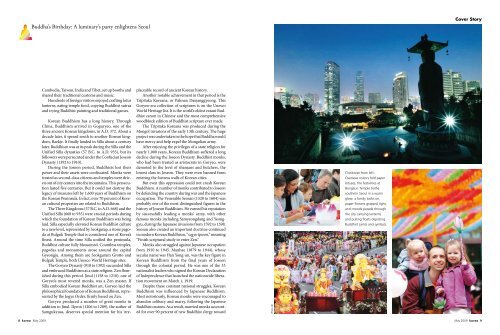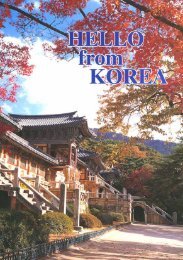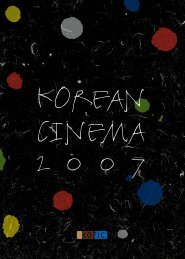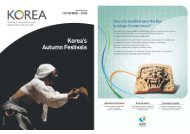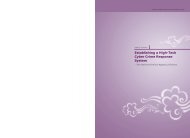2005-2162 The Buddha’s birthday illuminates Seoul
The Buddha's birthday illuminates Seoul - Korea.net
The Buddha's birthday illuminates Seoul - Korea.net
- No tags were found...
Create successful ePaper yourself
Turn your PDF publications into a flip-book with our unique Google optimized e-Paper software.
<strong>Buddha’s</strong> Birthday: A luminary’s party enlightens <strong>Seoul</strong><br />
Cover Story<br />
Cambodia, Taiwan, India and Tibet, set up booths and<br />
shared their traditional customs and music.<br />
Hundreds of foreign visitors enjoyed crafting lotus<br />
lanterns, eating temple food, copying Buddhist sutras<br />
and trying Buddhist painting and traditional games.<br />
Korean Buddhism has a long history. Through<br />
China, Buddhism arrived in Goguryeo, one of the<br />
three ancient Korean kingdoms, in A.D. 372. About a<br />
decade later, it spread south to another Korean kingdom,<br />
Baekje. It finally landed in Silla about a century<br />
later. Buddhism was at its peak during the Silla and the<br />
Unified Silla dynasties (57 B.C. to A.D. 935), but its<br />
followers were persecuted under the Confucian Joseon<br />
Dynasty (1392 to 1910).<br />
During the Joseon period, Buddhists lost their<br />
power and their assets were confiscated. Monks were<br />
treated as second-class citizens and temples were driven<br />
out of city centers into the mountains. This persecution<br />
lasted five centuries. But it could not destroy the<br />
legacy of treasures left by 1,600 years of Buddhism on<br />
the Korean Peninsula. In fact, over 70 percent of Korean<br />
cultural properties are related to Buddhism.<br />
<strong>The</strong> Three Kingdoms (57 B.C. to A.D. 668) and the<br />
Unified Silla (668 to 935) were crucial periods during<br />
which the foundation of Korean Buddhism was being<br />
laid. Silla especially elevated Korean Buddhist culture<br />
to a new level, represented by Seokgatap, a stone pagoda<br />
at Bulguk Temple that is considered one of Korea’s<br />
finest. Around the time Silla unified the peninsula,<br />
Buddhist culture fully blossomed. Countless temples,<br />
pagodas and monuments arose around the capital<br />
Gyeongju. Among them are Seokguram Grotto and<br />
Bulguk Temple, both Unesco World Heritage sites.<br />
<strong>The</strong> Goryeo Dynasty (918 to 1392) succeeded Silla<br />
and embraced Buddhism as a state religion. Zen flourished<br />
during this period. Jinul (1158 to 1210), one of<br />
Goryeo’s most revered monks, was a Zen master. If<br />
Silla embodied Korean Buddhist art, Goryeo laid the<br />
philosophical foundation of Korean Buddhism, represented<br />
by the Jogye Order, firmly based on Zen.<br />
Goryeo produced a number of great monks in<br />
addition to Jinul. Ilyeon (1206 to 1289), the author of<br />
Samgukyusa, deserves special mention for his irreplaceable<br />
record of ancient Korean history.<br />
Another notable achievement in that period is the<br />
Tripitaka Koreana, or Palman Daejanggyeong. This<br />
Goryeo-era collection of scriptures is on the Unesco<br />
World Heritage list. It is the world’s oldest extant Buddhist<br />
canon in Chinese and the most comprehensive<br />
woodblock edition of Buddhist scripture ever made.<br />
<strong>The</strong> Tripitaka Koreana was produced during the<br />
Mongol invasions of the early 13th century. <strong>The</strong> huge<br />
project was undertaken in the hope that Buddha would<br />
have mercy and help expel the Mongolian army.<br />
After enjoying the privileges of a state religion for<br />
nearly 1,000 years, Korean Buddhism suffered a long<br />
decline during the Joseon Dynasty. Buddhist monks,<br />
who had been treated as aristocrats in Goryeo, were<br />
demoted to the level of shamans and butchers, the<br />
lowest class in Joseon. <strong>The</strong>y were even banned from<br />
entering the fortress walls of Korean cities.<br />
But even this oppression could not crush Korean<br />
Buddhism. A number of monks contributed to Joseon<br />
by defending the country during war and the Japanese<br />
occupation. <strong>The</strong> Venerable Seosan (1520 to 1604) was<br />
probably one of the most distinguished figures in the<br />
history of Joseon Buddhism. He earned his reputation<br />
by successfully leading a monks’ army, with other<br />
famous monks including Samyeongdang and Yeonggyu,<br />
during the Japanese invasions from 1592 to 1598.<br />
Seosan also created an important doctrine continued<br />
in modern Korean Buddhism, “sagyo ipseon,” meaning<br />
“Finish scriptural study to enter Zen.”<br />
Monks also struggled against Japanese occupation<br />
from 1910 to 1945. Manhae (1879 to 1944), whose<br />
secular name was Han Yong-un, was the key figure in<br />
Korean Buddhism from the final years of Joseon<br />
through the colonial period. He was one of the 33<br />
nationalist leaders who signed the Korean Declaration<br />
of Independence that launched the nationwide liberation<br />
movement on March 1, 1919.<br />
Despite these constant national struggles, Korean<br />
Buddhism was influenced by Japanese Buddhism.<br />
Most notoriously, Korean monks were encouraged to<br />
abandon celibacy and marry, following the Japanese<br />
Buddhist custom. As a result, married monks accounted<br />
for over 90 percent of new Buddhist clergy toward<br />
[Press Q]<br />
Clockwise from left:<br />
Overseas visitors fold paper<br />
lotuses; the festivities at<br />
Bongeun Temple bathe<br />
southern <strong>Seoul</strong> in a warm<br />
glow; a family looks on,<br />
paper flowers grapsed tight,<br />
and crowds parade through<br />
the city carrying lanterns<br />
and pulling floats depicting<br />
Buddhist saints and symbols.<br />
8 korea May 2009<br />
May 2009 korea 9


